How I Do It: Marlene Cummings Shares an Implementation Toolbox
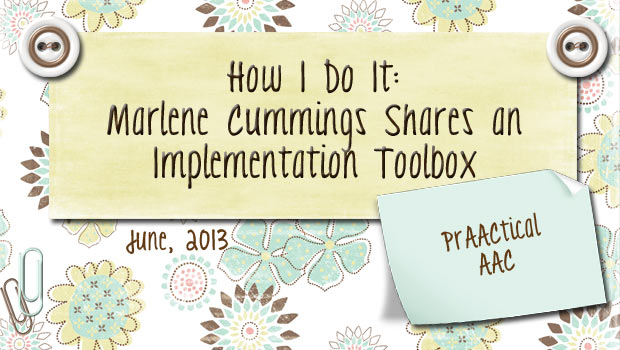
Now that the school year is winding down, some of you have a little more time to read, process, and prepare for next year. We are really excited to share more ideas from Marlene Cummings, one of the most experienced AAC SLPs that we know. Those of you who have been following Marlene’s posts on the AAC implementation will be pleased to see the next part of the Framework for Success that she developed with the AAC Team at Oakland School District. If you missed her first and second posts, go take a peek at them when you can. 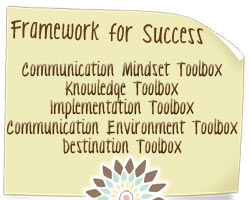
5 Things in our “Implementation Toolbox”
When we begin the process of implementing AAC it is important to consider our “thinking”. We always want to approach every student, every team and every classroom with as much wisdom and respect as possible.
One of my colleagues, Dr. Penny Hatch, from UNC Chapel Hill frequently draws us back to a concept called the “Least Dangerous Assumptions” written by Anne Donnellan in 1994. “Least Dangerous Assumption” states that in the absence of absolute evidence, it is essential to make the assumption that, if proven to be false, would be least dangerous to the individual. Explore this concept more at http://www.inclusive-solutions.com/leastdangerousassumption.asp.
Several months ago I heard another phrase that resonated with me and have determined to practice. “Assume competence”. I totally missed the rest of the lecture as I mulled this idea around. I began to explore what that would look like as I interacted with my teams, their students, families and my colleagues. It was life changing. I have also been the recipient of this belief system and approach from others. Those are the people I “show up” best for because they believe I will. I encourage you to consider how many of our interactions and outcomes might be different if we embraced this concept.
1. Vocabulary instruction: We must remember that we need to directly instruct our students in language as well as teach the vocabulary and the symbols in their communication system. Oftentimes we get so distracted with the “thing” (the communication device and all of it’s parts, set up, charging, programming etc) that we forget this is really ALL about LANGUAGE and the vocabulary they need to express themselves.
Because this task can seem daunting when attempting to represent all this vocabulary visibly, we often fall into the “quiz mode” trap; i.e. asking lot’s of questions, having students make choices from items we picked and directing most of the communication interactions. This leaves little room for student initiations and multiple turn takes in a communicative exchange. It also doesn’t give our students enough experience exploring language to draw any conclusions about what they are seeing, hearing, and understanding.
Access to language, communication opportunities, and literacy throughout the day is imperative. We have been exploring a “work embedded professional learning” approach to support our teams in their AAC implementation process. One of the strategies we are exploring is including a specific vocabulary focus in the daily and weekly lesson plans emphasizing the purposes and functions of communication while linking directly to the literacy curriculum in the classroom. You will see an example being used by one of our teams in the communication environment toolbox. You can also check out these posts on Vocabulary Instruction In AAC.
2. A Core Vocabulary Approach: Core vocabulary in AAC typically refers to those words that are used most frequently and with the most versatility. Consider those words that are used about 80% of the time in daily communication but only make up about 20% of our vocabulary. This is what we call our “core” set of words. The larger portion of our vocabulary (80% of our words), which is typically used about 20% of the time, we refer to as fringe or expanded core. You can download our Core Vocabulary Characteristics here.
The concept of core vocabulary is not new, yet is taking on a whole new look with a project unfolding at the Center for Literacy and Disability Studies at UNC Chapel Hill. Our AAC team has been collaborating with Dr. Penny Hatch, Dr. Karen Erickson and Allison Dennis on a project that is looking at the vocabulary and communication demands of the Common Core Standards and the resultant core vocabulary set needed to support students with complex communication needs. You can see more about their work here.
I mentioned earlier that our AAC team began implementing a systematic “core vocabulary” approach to support our augmented communicators about18 months ago. The initial results are encouraging:
- Increased investment by staff (SLPs embraced “core vocabulary” quickly and effectively)
- Increase of multiple word phrases using our 32 core words
- Use of words not easily represented and not taught specifically, but rather embedded in daily communicative exchanges (frequency of use and modeling works)
- Increased expectations for students to use language in flexible ways (demonstrating more functions)
- Use of AAC systems increased while the focus shifted from the device and programming to the language and vocabulary needed for communication.
Now let’s talk about the fringe (also referred to as expanded core) vocabulary. One of the great challenges in AAC is deciding what fringe vocabulary should be made available, how much and where.
We were pretty good at having lot’s of possible snack pictures on our placemats. But what to do when we are reading the “Hungry Caterpillar” and he wants to eat sausage? Do we add all the food items to the device; make a separate communication display for each story? Hmmm, the dilemma.
Remember, at this point we were attempting to add fringe vocabulary to an early childhood classroom. Years ago I came across a wonderful tool I called my “communication dictionary”. Its copyright name is “Print-n-Communicate” and can be purchased from Mayer Johnson Inc. We took this booklet and added our “core vocabulary” to the back so it folded out to the left allowing the use of core with fringe galore to the right. No matter what book we were reading or what topic we were discussing, we had most of the fringe vocabulary we needed most of the time. This led us quickly to the realization that for us the “world of fringe” was our entire classroom. With core in hand the fringe became the pictures in the book we were reading, the items in the play area, the instructional materials at each station, the colored crayons in the art area.
Our students began to use the core words as their base and developed a wonderful flexibility in finding the fringe words they needed. The communication dictionary became our mainstay in the classroom. We began to expand our thinking about words, word classes, and how to help our students think about words in categories. With our core vocabulary strategically positioned for optimum modeling and opportunity, and the fringe vocabulary everywhere we were able to make thoughtful and timely decisions when adding personalization to student AAC systems and not panicking if a word they wanted wasn’t in their systems yet. It was a win-win approach.
One of the work embedded professional learning teams (30 + professionals serving students birth to 5) decided to create a “communication dictionary” for each of their classrooms with their core words folding out from the back of the book. It was quite an undertaking, but at last count each team had one and 50 more were in the making to add to the classrooms and share with families.
3. Modeling: Typically developing communicators have hundreds of opportunities to see communication take place in their day. They are able to draw conclusions and gain understanding of language as they see, hear, and experience communication. Its purposes, functions and power, become evident. Emergent communicators using AAC have little opportunity to see communication being modeled using AAC, which is the output we expect them to use. One of these communication partner strategies that we see having a profound impact is Aided Language Input, which provides a model of the language target expressed through AAC. Carole Zangari shares it like this: “Hearing the target language is good, but hearing and seeing it using the same AAC system the child is learning is a big part of what will catalyze language acquisition. (If you are not prepared to use AAC when you talk, you better be prepared for the child to learn very slowly.)” You can see posts on ‘Language Facilitation Strategies” and “Speaking AAC.”
4. Opportunities: Daily we emphasize with teams the need for our communicators to have many, many, many opportunities to communicate during a day. This is not just during “speech” time or during the “speech center” or when the devices/symbols are available or when they can be understood….you get the point. And yet it never seems to match the opportunities that typical communicators have to figure out what communication is, what it does and the power it holds. Jane Korsten made a profound observation that continues to resonate among our teams as they consider how to embed communication opportunities into everything.
This is not as much about where, when and how we provide service, but what would our “AAC communication opportunity scale” look like in comparison to the “communication opportunity scale” for typical communicators?
One way to ensure that there are opportunities galore in the communication environment is to imagine what you would include if you created an “AAC Communication Opportunity Scale”. Here are a few possibilities:
- Examine the educational day in light of potential communicative opportunities. Here are a few. I am sure you can think of more. Remember all of these would be visibly represented.
- Purposes of communication
- Functions of communication
- Frequency of occurrences of targeted core words and phrases
- Occurrence of Functions of communication and targeted core words in specific activities
This is one example. I am sure there are many more out there. The goal is to be intentional when we design our instruction always keeping in mind the communication opportunities we are providing. This was introduced to one of our teams who have been implementing a “core vocabulary” approach to communication. We wanted to explore ways to get the purposes and functions of communication on their radar in a more systematic way. They described it this way: “Having basic understanding of core and implementing AAC devices, this table really hits home on how dynamic and interwoven communication is in our everyday life.”
|
AAC Communication Opportunity Scale |
|||||
|
Purposes of communication |
|||||
| Focus | Target phrases | When (Instructional activity) | Where(Communication environment) | How many (Communication opportunities to use each phrase) | |
| Express wants/needs | Want go play; My turn (In this example “my turn” provides more opportunities for more communicative exchanges than “want go play” which was only able to be used 2 times to get to the location) | Acting out a story;–Play | Literacy corner;–Lego table | 2;–6 | |
| Gain/share information | |||||
| Build/sustain relationships | |||||
| Participate in social etiquette | |||||
|
Target Functions of Communication (chosen each week/month) |
|||||
| Request | |||||
| Protest | |||||
| Comment | |||||
|
Chosen Core Words (for the week/month) |
|||||
| Want | |||||
| More | |||||
5. Access to language all day long: This topic could take on a life of its own. This and “core vocabulary” are my passions, so I will only share a bit at this time. Communication is everywhere. The goal is to give our AAC communicators the opportunity to hear, see, manipulate and express language in every way possible, as often as possible with as much impact as possible as soon as possible.
|
Instructional Activity |
||||
| Activity | Purposes of Communication | Functions | Core Words | Phrases |
| Social Group (During social group focus is on teaching the feeling “sad”) | Gaining and sharing information | Commenting | I, not, me, my, you, go, get, turn | Sad not get; I sad; Sad not my; No turn; Sad no go; Sad no friend;Sad I wait |
I have the opportunity to work in classrooms where more than one student would benefit from AAC systems and supports. First, we inundate the communication environment with vocabulary, starting with core. We make sure it is everywhere. This allows communication to be modeled and used by as many staff and students as possible, which more naturally represent what our verbal communicators experience in their “world of communication”. In an “AAC world of communication,” an AAC communicator would be able to participate in the purposes of communication, demonstrate the functions of communication, have access to a set of core words and use language flexibly and powerfully. They would learn language, use language to learn, and competently communicate who they are and what they know.
Marlene’s posts do not disappoint! Stay tuned for her next post on the Communication Environment.
Filed under: PrAACtical Thinking
Tagged With: AAC team, classroo, education, Marlene Cummings, schools, strategies
This post was written by Carole Zangari
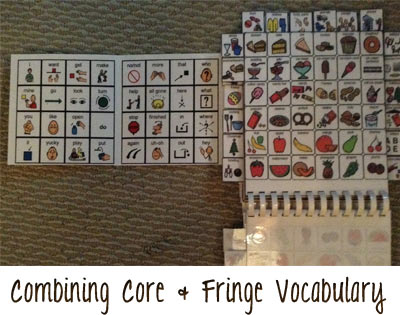

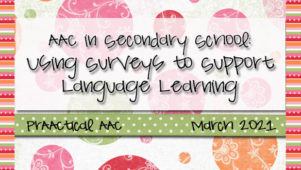
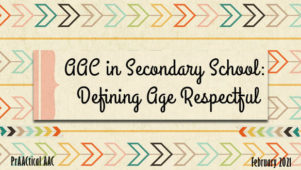
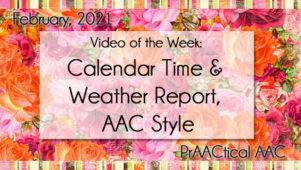
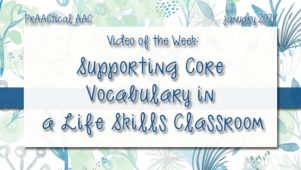
3 Comments
Great explanation, workable solutions! I’m excited to share your ideas!
Vicki
I would love to get any feedback you receive. Thanks so much for your perspective.
Marlene
I was hoping you would share how you constructed the board pictured on the Pin “How I Do It: Marlene Cummings Shares an Implementation Tool..combining core and fringe vocabulary. I looks like the core folds out from the side of the fringe.